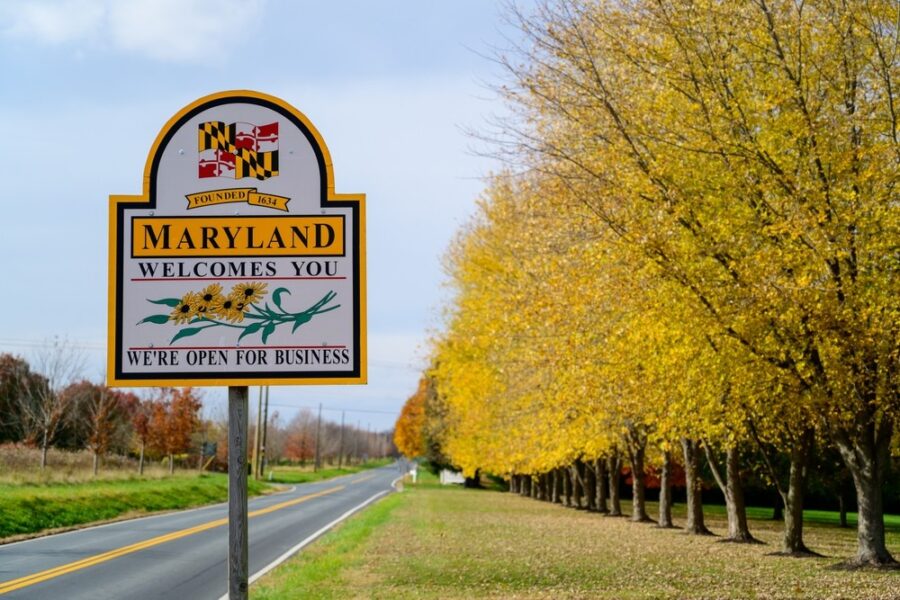Maryland sees rise in problem gambling after sports betting launch

Disordered gambling in Maryland has risen since the legalization of sports betting, with nearly two in five bettors showing signs of addiction or risky behavior.
According to data collected between May and July 2024 by the Maryland Center of Excellence on Problem Gambling, there has been a 42% rise in adults showing signs of problem gambling since sports betting was launched statewide in November 2022, increasing from 4% to 5.7%.
Gambling counselors mentioned the surge is evident even without the new data.
Will Hinman, a Certified Peer Recovery Specialist at the Maryland center, said, “I’ve definitely taken a lot more calls since sports gambling has been legalized over the last two or three years than my previous four years combined.”
Dr. Deborah Haskins, former president of the Maryland Council on Problem Gambling, stated that most calls originate from mothers seeking assistance for their sons aged 18 to 34. “They’re reaching the proportion of disordered gambling a lot quicker, maybe in a matter of weeks”, she added.
Maryland schools will begin teaching gambling awareness this fall as part of the health education curriculum to address this issue.
Heather Eshleman, prevention manager at the Maryland Center of Excellence, called it “a big deal” for reaching students before they can legally gamble.
In August, Maryland Lottery and Gaming Control Commission also issued a warning to residents to stick to regulated sportsbooks ahead of the NFL season.
Charlotte Capewell brings her passion for storytelling and expertise in writing, researching, and the gambling industry to every article she writes. Her specialties include the US gambling industry, regulator legislation, igaming, and more.
Verticals:
Sectors:
Topics:
Dig Deeper
The Backstory
How the stakes around legal betting escalated
The current flashpoint over problem gambling did not appear overnight. It traces to the rapid spread of legal sports wagering, a deluge of digital products and marketing, and uneven consumer protections. In the Mid-Atlantic, early data offered a warning: after Maryland launched statewide sports betting in late 2022, health officials recorded a marked uptick in signs of addiction and risky play among adults. Similar patterns emerged in North Carolina after mobile sportsbooks went live, reshaping who seeks help and how quickly problems develop. The policy response has struggled to keep pace, even as gambling suppliers tout growth and state regulators grapple with gray-market offerings that look and feel like betting but sit outside traditional guardrails.
Maryland’s early alarms
Maryland’s public health monitors were among the first to document a post-legalization surge. Between May and July 2024, the Maryland Center of Excellence on Problem Gambling found a 42% rise in adults showing signs of problem gambling since sports betting rolled out statewide, moving from four percent to 5.7%. Officials warned residents to stick to regulated sportsbooks as the NFL season neared. Counselors reported that calls spiked, with many coming from parents concerned about young men. The education system responded by adding gambling awareness to health curricula this fall, a shift aimed at prevention before students reach legal age. See Complete iGaming’s coverage: Maryland sees rise in problem gambling after sports betting launch.
The regulatory front also hardened. The Maryland Lottery and Gaming Control Commission ordered three commodity trading platforms to stop offering contracts tied to sports events to state residents, arguing the products were functionally indistinguishable from sports betting and bypassed licensing, age checks and geolocation. The action highlighted a broader enforcement challenge: products that mirror sportsbook risk and reward but operate under different statutes. Since legal sports betting began in December 2021, licensed sportsbooks have contributed nearly $150 million to the Blueprint for Maryland’s Future Fund through a 15% tax on revenue, a levy the commission said gray-market offerings were sidestepping. Read more: Commodity traders ordered to cease offering sports events contracts in Maryland.
North Carolina’s demographic shift
North Carolina’s helpline data underscored who is being pulled in by legal mobile betting and how quickly harms can develop. For the first time, sports wagering surpassed the lottery as the top reason people contacted the state’s Problem Gambling Helpline, which handled more than 8,100 calls in the latest fiscal year, up over 11% from 2024. After sportsbooks launched in March 2024, callers skewed younger—often ages 18 to 34—and more likely to report problems that had developed within one year. Parents were frequently the ones reaching out about sports betting concerns, outpacing spouses who typically call about other forms of gambling. The shift mirrored broader usage data: lottery sales climbed to about $6.6 billion, propelled by digital instant games, even as retail fell. Lawmakers boosted funding for prevention and treatment, but the helpline’s experience suggested demand is growing faster than the traditional care system. Details here: North Carolina gambling helpline sees sports betting become highest reported problem.
A global echo and the role of advertising
The pressures are not unique to the United States. Australia’s national research shows a similar arc: more people gambling, more harm concentrated among younger adults, and a prominent role for sports betting alongside lotteries. The Australian Gambling Research Centre reported overall participation rising from 57% in 2019 to 65% in 2024, with 15% of respondents experiencing gambling-related harm in the past year, up from 11% in 2019. High-risk gambling affected 7.7% of regular gamblers and was linked with financial and mental health harms, as well as family violence. Researchers tied elevated risk for those ages 18 to 24 to targeted advertising, intensifying pressure on policymakers to consider bans on online gambling ads recommended in the 2023 Murphy report. Context from Complete iGaming: Australian study suggests gambling problems on the rise.
Industry momentum complicates the response
While public health indicators flash, industry results remain resilient, with suppliers and operators innovating and expanding. Light & Wonder, a major content and platform provider, reported second-quarter igaming revenue up nine percent to $81 million, with segment AEBITDA up 17% year over year. Consolidated AEBITDA climbed and net income rose 16% even as total revenue ticked down one percent. The company launched new branded content, including a Wizard of Oz slot, to strengthen engagement. Those figures underline the commercial forces at work: platforms continue to deepen digital reach and product mixes, often through high-frequency, mobile-first experiences that regulators say can accelerate loss cycles for younger players. For the full breakdown: Light & Wonder sees igaming revenue rise 9% to US$81 million in Q2.
The tension is clear. As content pipelines and user acquisition grow more sophisticated, prevention and treatment infrastructures must adapt to faster risk onset, larger and younger cohorts, and always-on access. That gap is where state programs and nonprofits are trying to innovate.
New tools and safety nets emerge
One experiment comes from West Virginia, where the Problem Gambling Help Network introduced a recovery app built with health tech firm Chess Health. The tool offers 24/7 crisis support, virtual meetings, daily check-ins and education, integrating with the 1-800-GAMBLER hotline and forums. The aim is to replicate substance-use recovery supports in a gambling context, address limited in-state treatment options and flag co-occurring conditions such as alcohol or drug misuse through screening surveys. Early adoption will be watched by neighboring states facing similar service gaps and demographics. Coverage: West Virginia launches gambling addiction app.
Education is the other front. Maryland’s plan to integrate gambling awareness into school health curricula seeks to reach students before they enter legal markets or are targeted by promotions tied to sports content. Advocates argue that prevention messaging needs to match the ubiquity and sophistication of betting ads and features. If successful, classroom interventions, in-app support and stricter enforcement against unlicensed betting look-alikes could form a three-part framework: reduce exposure and misinformation, offer immediate, stigma-light support and close regulatory loopholes.
What to watch next
The policy agenda is filling up. Expect scrutiny of prediction-market and “financialized” sports products, broader ad restrictions focused on young adults, and more funding tied to helplines and digital treatment. Data sharing between operators and public health agencies could be pivotal, particularly around early-warning signals such as rapid deposit cadence, late-night play and chasing losses. Meanwhile, industry earnings reports will test whether safer-gambling features and marketing curbs can coexist with growth targets. The experience of Maryland and North Carolina suggests the first two years after launch are critical for shaping norms and support systems. The longer regulators take to align prevention, enforcement and market design, the higher the cost could be for families and state budgets down the line.








